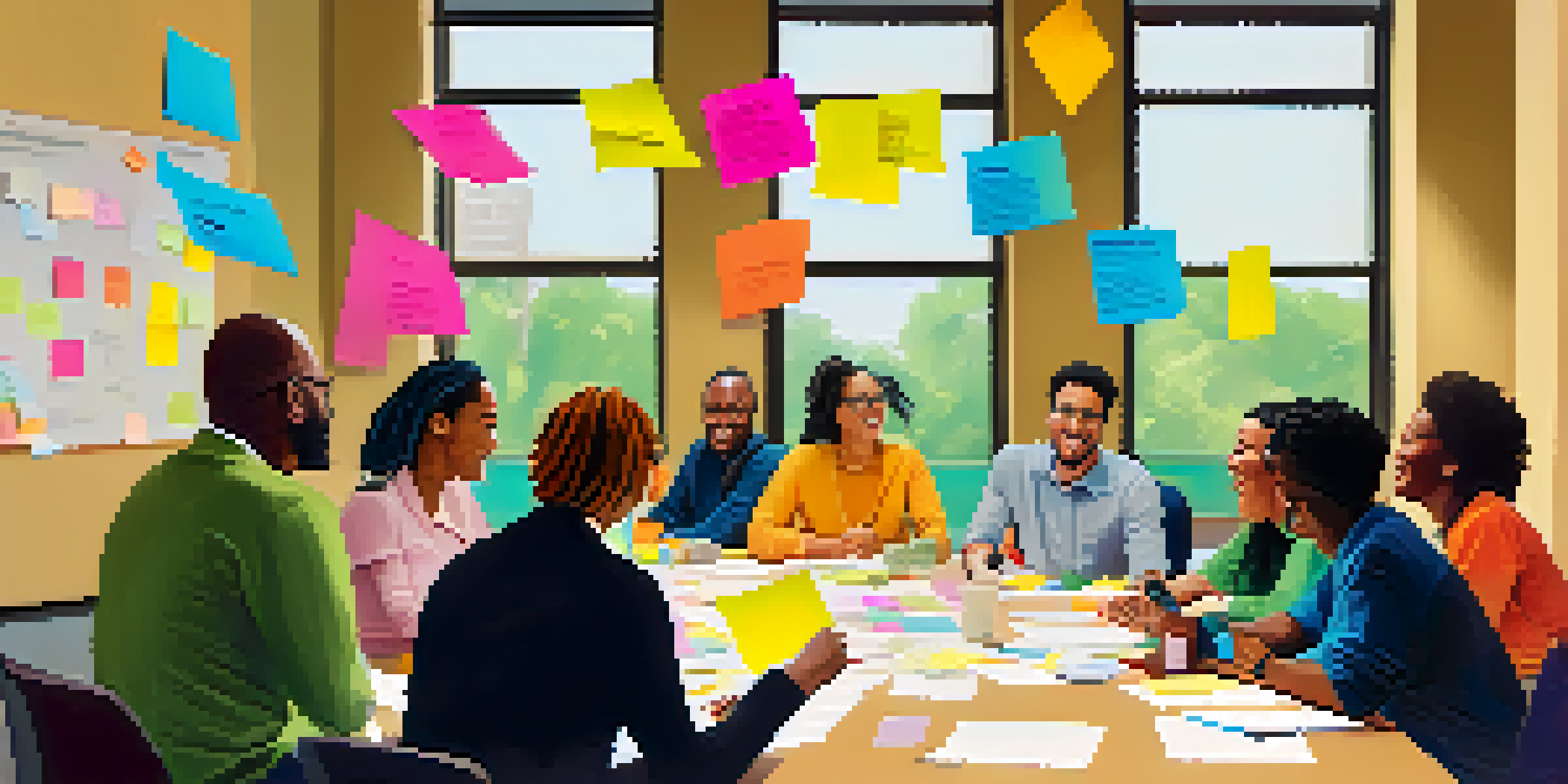Social Learning Approaches in Nonprofit Organizations

Understanding Social Learning in Nonprofits
Social learning refers to the process of learning through interactions with others, primarily through observation and imitation. In nonprofit organizations, this approach becomes vital as it encourages collaboration and shared knowledge among staff and volunteers. By leveraging collective experiences, nonprofits can enhance their organizational culture and improve overall effectiveness.
The greatest danger in times of turbulence is not the turbulence; it is to act with yesterday's logic.
For instance, when team members share their successes and challenges, it creates an environment of continuous learning. This communal approach not only fosters stronger relationships but also empowers individuals to innovate and adapt. The result is a more dynamic organization that can respond to the ever-changing needs of its community.
Moreover, social learning can lead to more engaged stakeholders. When everyone is involved in the learning process, there’s a shared sense of ownership and accountability. This engagement can drive motivation and commitment, which are crucial for the success of any nonprofit initiative.
The Role of Technology in Social Learning
In today's digital age, technology plays a pivotal role in facilitating social learning. Online platforms and social media can be powerful tools for nonprofits to connect their members and volunteers. These tools allow for real-time sharing of information, resources, and experiences, breaking down geographical barriers that often limit collaboration.

For example, organizations can create dedicated forums or groups on platforms like Facebook or Slack, where members can discuss ideas, share best practices, and seek advice. This virtual environment not only fosters learning but also builds a supportive community that encourages participation. The more accessible the information, the more likely individuals will engage.
Social Learning Enhances Collaboration
Nonprofits can boost effectiveness by fostering a culture of collaboration and knowledge sharing among staff and volunteers.
Additionally, webinars and online training sessions can be utilized to enhance skills across the board. By incorporating diverse formats, nonprofits can cater to different learning styles, ensuring everyone has the opportunity to learn and contribute. This flexibility is essential for nurturing an adaptive and resilient workforce.
Creating a Social Learning Culture
Establishing a culture of social learning within a nonprofit requires intentional effort. Leaders must model collaborative behavior, demonstrating the value of sharing knowledge and experiences. When leaders actively participate in learning initiatives, they set the tone for the rest of the organization, encouraging others to follow suit.
Collaboration allows us to know more than we are capable of knowing by ourselves.
One effective method is to create regular opportunities for team members to collaborate on projects or share insights during meetings. For instance, implementing 'lunch and learn' sessions can provide a relaxed atmosphere where staff can share expertise and learn from one another. These informal gatherings can spark creativity and foster stronger interpersonal relationships.
Additionally, recognizing and rewarding collaborative efforts can further reinforce a social learning culture. When individuals see that their contributions to collective learning are valued, they are more likely to engage and take initiative. This recognition not only motivates individuals but also strengthens the organization as a whole.
Benefits of Social Learning for Nonprofits
The benefits of adopting social learning approaches in nonprofits are manifold. First and foremost, it enhances the organization’s capacity to adapt to changes in the environment. By continuously learning from one another, nonprofits can pivot quickly when faced with new challenges or opportunities, ensuring their programs remain relevant.
Moreover, social learning fosters innovation, as diverse perspectives lead to creative problem-solving. When team members feel comfortable sharing ideas, they are more likely to contribute unique solutions that can drive the organization forward. This collaborative atmosphere can lead to more effective strategies and improved outcomes for the communities served.
Technology Facilitates Learning
Digital tools and platforms break down barriers, enabling real-time information sharing and creating supportive learning environments.
Lastly, social learning can significantly enhance employee satisfaction and retention. When individuals feel that their growth is prioritized and that they are part of a supportive community, they are more likely to remain committed to the organization. This stability can be crucial for nonprofits, which often rely on a dedicated and passionate workforce.
Challenges in Implementing Social Learning
While the benefits of social learning are clear, implementing such approaches in nonprofits can present challenges. One significant hurdle is the existing organizational culture, which may not prioritize collaboration or knowledge sharing. In these cases, it’s essential to address any resistance to change and demonstrate how social learning can enhance overall effectiveness.
Another challenge is the varying levels of technological proficiency among staff and volunteers. Not everyone may be comfortable using digital tools to connect and share knowledge. Providing training and support can help bridge this gap and ensure that all members feel equipped to participate in social learning initiatives.
Lastly, measuring the impact of social learning can be complex. Nonprofits must develop clear metrics to assess the effectiveness of their social learning strategies. This could include tracking engagement levels, gathering feedback, and evaluating how shared learning translates into improved performance or outcomes.
Real-Life Examples of Social Learning in Action
Several nonprofit organizations have successfully implemented social learning approaches, yielding impressive results. For example, a nonprofit focused on environmental conservation created an online platform for volunteers to share their field experiences and best practices. This initiative not only improved knowledge sharing but also led to innovative environmental projects that benefitted the community.
Another example is a healthcare nonprofit that hosted regular peer-led workshops, allowing staff to learn from each other's expertise. By fostering an environment where everyone could contribute, they enhanced their service delivery and improved patient outcomes. This approach demonstrated the power of collective learning in driving impactful change.
Implementing Social Learning Challenges
While beneficial, nonprofits face challenges such as resistance to change, varying tech skills, and difficulties in measuring impact.
These real-life examples highlight that social learning isn't just a theoretical concept; it can be a transformative practice. By observing and learning from one another, nonprofits can harness the collective wisdom of their teams, leading to greater effectiveness and fulfillment in their missions.
Future Trends in Social Learning for Nonprofits
As the nonprofit sector continues to evolve, social learning approaches will likely become increasingly important. One emerging trend is the incorporation of artificial intelligence (AI) and machine learning to facilitate personalized learning experiences. By analyzing individual learning patterns, these technologies can recommend resources and connections that enhance the learning journey.
Another trend is the growing emphasis on diversity and inclusion in social learning initiatives. Nonprofits are recognizing the value of diverse perspectives and experiences in fostering a richer learning environment. By creating inclusive spaces where everyone feels valued, organizations can tap into a wealth of knowledge that drives innovation and effectiveness.

Finally, the future may see a shift toward hybrid learning models that combine in-person and virtual interactions. This flexibility can accommodate different learning preferences and ensure that all members can participate. By embracing these trends, nonprofits can continue to build strong, collaborative cultures that empower their teams and enhance their impact.